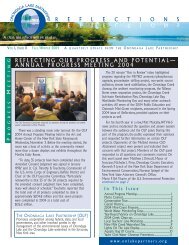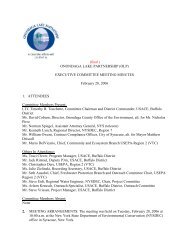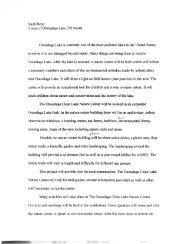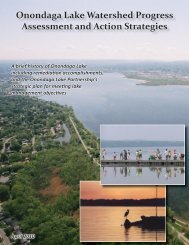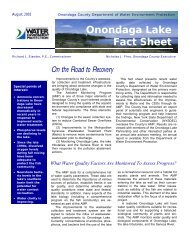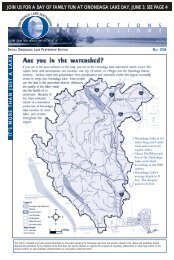Habitat Plan 2 - Onondaga Lake Partnership
Habitat Plan 2 - Onondaga Lake Partnership
Habitat Plan 2 - Onondaga Lake Partnership
You also want an ePaper? Increase the reach of your titles
YUMPU automatically turns print PDFs into web optimized ePapers that Google loves.
DRAFTWhite perch is a warm water species.being conducted under the leadership of Professor Nelson Hairston atCornell University and have not yet been published.Since the early 1990s, zebra mussel (Dreissena polymorpha) veligershave been entering <strong>Onondaga</strong> <strong>Lake</strong>. However, despite the availabilityof appropriate substrate and food, and near-optimal temperature andprimary water chemistry requirements, adult densities remainedextremely low in the lake through 1998 (Effler, 1996; Spada et al.,2002). This may have been related to the negative effects on early lifestages of zebra mussels from high concentrations of total ammonia (T-NH 3 ) and free (unionized) ammonia (NH 3 ) (Spada et al., 2002).Following abrupt decreases in concentrations of T-NH 3 and NH 3coincident with improvements at METRO, high densities of zebramussels were first documented in the lake in 1999 (maximum of65,000 individuals/m 2 ) (Spada et al., 2002). The presence of zebramussels has had a significant impact on water quality and ecologicalconditions within the lake including increased aquatic plant growth dueto increased water clarity and stabilized sediments (EcoLogic et al.,2006).The benthic macroinvertebrate community in <strong>Onondaga</strong> <strong>Lake</strong> wasassessed in 2008 during the Honeywell baseline monitoring program(Parsons, 2009e). Surface sediments at 18 locations in the littoral zone(all at 3.2 to 5 feet water depth) around the lake were sampled andbenthic macroinvertebrates were identified from 5 replicates perlocation. Procedures were consistent with the 2002 NYSDEC Divisionof Water’s Quality Assurance Work <strong>Plan</strong> for Biological StreamMonitoring in NYS. Zebra mussels were fairly dominant at mostlocations, along with tubificid worms (Annelida) and scuds (Amphipoda).Aquatic insects were not highly abundant and were dominated bymidges (Diptera: Chirononmidae).2.4.4 FishesSUNY ESF has been studying fishes in <strong>Onondaga</strong> <strong>Lake</strong> under thedirection of Dr. Neil Ringler since 1986. Much of their earlier work wasincorporated into the BERA (TAMS, 2002b). More recent work hasincluded trapnet and gillnet fish sampling at up to 30 locations andcharacterization of the several populations. These studies are ongoing,including collection of additional field data in 2007, 2008 and 2009, withthe results recently defended in master’s theses of SUNY ESF students(Johnson, 2009; Kirby, 2009; Siniscal, 2009). <strong>Onondaga</strong> County’s AMPrepresents one of the most long-term and comprehensive lake wide fishmonitoring program in <strong>Onondaga</strong> <strong>Lake</strong>. The 2005 annual report(Ecologic, 2006) is available on the <strong>Onondaga</strong> County website,(www.ongov.net), and an overview of the fish community presented inthis version of the AMP is presented below.Contrary to the popular perception that <strong>Onondaga</strong> <strong>Lake</strong> is a dead lake,recent studies of the fish in <strong>Onondaga</strong> <strong>Lake</strong> have documented warmwater, cool water, and coldwater fish species in the lake throughoutmost of the year. Cold water species reproduction in the lake has notbeen documented; until recently they did not reside in the lake yearround.Fish surveys conducted in the late 1980s through today havePARSONS | Remedial Design Elements for <strong>Habitat</strong> Restoration 65



